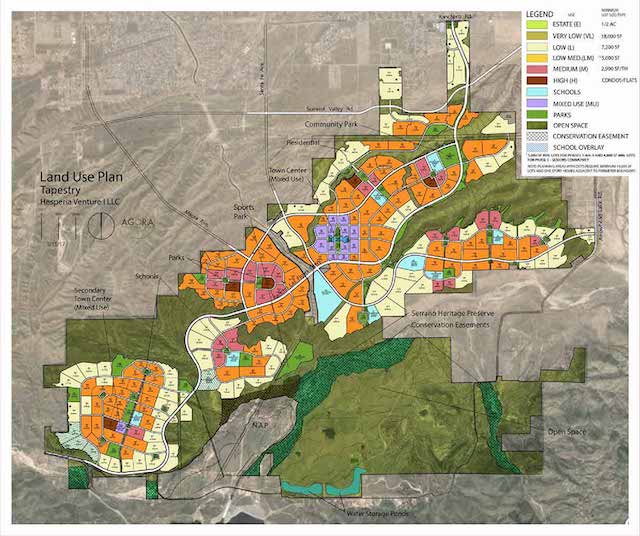By The Antiplanner
Although master-planned communities are quite common on Texas, New Mexico, and Arizona, they are few and far between in California thanks to strict land-use laws and an anti-development mentality. So it is good to learn that a 15,663-home master-planned community will be built near Hesperia, just a half-hour north of San Bernardino and a little more than an hour from downtown Los Angeles.
To be called Tapestry, the community will be built on 9,366 acres of former ranch lands, of which 4,933 acres will be set aside as open spaces and parks. The homes centering around a 700,000-square-foot commercial area will include all kinds of housing from condos and town homes to single-family homes on 18,000- and 21,500-square-foot lots.
Click image for a larger view.
This development should provide a little welcome relief to one of the most unaffordable housing markets in the country. According to Realtor.com, median home prices in Hesperia are $380,000, which is pretty high, but just over Cajon Pass in Rancho Cucamonga, they are close to twice as much at $675,000. If more communities like Tapestry were being built, the greater Los Angeles area would be a lot more affordable.
The problem is that the Tapestry master-planned community was first proposed in 1987 — that’s 34 years ago — and not a single house has yet been built. The original proposal was approved by the local government in 1990, but environmental groups including the Sierra Club and Center for Biological Diversity sued, and the lawsuit wasn’t resolved until 2017, by which time the original developer was bankrupt. The settlement reduced the number of homes by 533 and gave environmentalists an option to buy some of the land, an option they probably won’t exercise because why bother to pay for it when the developers aren’t allowed to develop it anyway?
The lawsuit also mandates that developers install 2 kilowatts of solar panels for every 1,000 square feet of commercial or residential development. While this sounds good, it will also increase up-front housing costs, making housing less affordable than it might have been.
That’s the California way: delay developers into bankruptcy, pile on the development costs, and then complain that greedy developers are responsible for high housing prices.
Originally published by The Antiplanner. Republished with permission.












